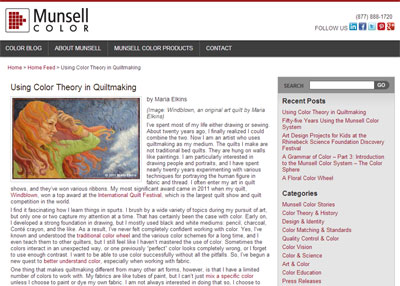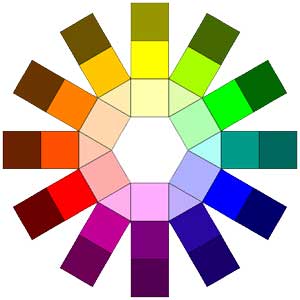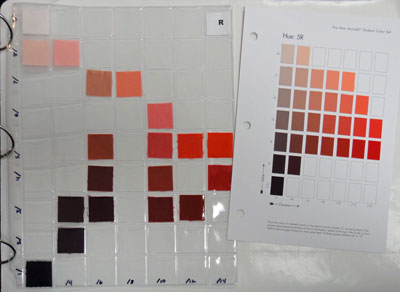 Last month, I was contacted by Jannette who manages the Munsell Color Blog. Their blog features people who use Munsell Color in their work or other activities, and she asked if I would be interested in writing a guest post for their blog about how I use Munsell Color theory in my quiltmaking. Of course, I said yes! What a great opportunity to introduce art quilts to a greater audience. So today, my article, Using Color Theory in Quiltmaking, was published.
Last month, I was contacted by Jannette who manages the Munsell Color Blog. Their blog features people who use Munsell Color in their work or other activities, and she asked if I would be interested in writing a guest post for their blog about how I use Munsell Color theory in my quiltmaking. Of course, I said yes! What a great opportunity to introduce art quilts to a greater audience. So today, my article, Using Color Theory in Quiltmaking, was published.
 Here is a brief explanation of what makes the Munsell Color Theory a little different from the standard color wheel we may be familiar with. We are used to seeing a circle of colors with the primaries red, yellow, and blue. More recently, a color wheel with cyan, magenta, and yellow as primaries has become more popular. These color wheels are good because they show basic relationships between the colors. Based on these color wheels, there are various color schemes that we can use with a reasonable degree of success.
Here is a brief explanation of what makes the Munsell Color Theory a little different from the standard color wheel we may be familiar with. We are used to seeing a circle of colors with the primaries red, yellow, and blue. More recently, a color wheel with cyan, magenta, and yellow as primaries has become more popular. These color wheels are good because they show basic relationships between the colors. Based on these color wheels, there are various color schemes that we can use with a reasonable degree of success.
 Sometimes you might see this color wheel showing a wider range of values. It might show tints toward the center of the wheel and shades toward the outside. This can be very helpful in reminding us to use a wide variety of values. That’s what makes our quilts more interesting and dynamic.
Sometimes you might see this color wheel showing a wider range of values. It might show tints toward the center of the wheel and shades toward the outside. This can be very helpful in reminding us to use a wide variety of values. That’s what makes our quilts more interesting and dynamic.
The Munsell color theory not only takes into account hue (color) and value, but it also includes various intensities for each color. Munsell called this attribute of color “chroma.” To do this, Munsell pictured color in a 3-dimensional form instead of a flat circle. The brightest version of each color is shown along the circumference of the irregular sphere. Value is shown vertically with the darkest at the bottom and the lightest at the top. Then, each color also becomes more muted and more grayish as it moves to the center of the sphere. To see an example of this sphere, be sure to go to the Color Space and Solid page of the Munsell website.
 One of the learning exercises I did was to go through my Kona cottons and try to determine where they would be represented in a Munsell color sphere. On the right you see a color chart from the book, The New Munsell Student Color Set, Third Edition. The book includes ten charts for the five primary and five secondary colors. (Munsell divided the color wheel into ten divisions so his notation system could be based on the decimal system.) On the left you can see how I tried to find comparable colors from my stash of solid colored fabrics. Because commercial fabric comes in a limited number of colors, I could not completely fill out each chart, but I learned so much from the exercise. But, I still feel like I have so much to learn! It’s all a part of the adventure, isn’t it?
One of the learning exercises I did was to go through my Kona cottons and try to determine where they would be represented in a Munsell color sphere. On the right you see a color chart from the book, The New Munsell Student Color Set, Third Edition. The book includes ten charts for the five primary and five secondary colors. (Munsell divided the color wheel into ten divisions so his notation system could be based on the decimal system.) On the left you can see how I tried to find comparable colors from my stash of solid colored fabrics. Because commercial fabric comes in a limited number of colors, I could not completely fill out each chart, but I learned so much from the exercise. But, I still feel like I have so much to learn! It’s all a part of the adventure, isn’t it?
Comments
2 responses to “Munsell Color Blog”
Congrats Maria! Awesome article and getting quilting into the mainstream! I had never heard of this company and it was an interesting approach to the color wheel and color theory. Take care, Laurie
Munsell color theory is often used in industry because you can precisely locate a specific color and each one has a specific color code, which is based on the decimal system.